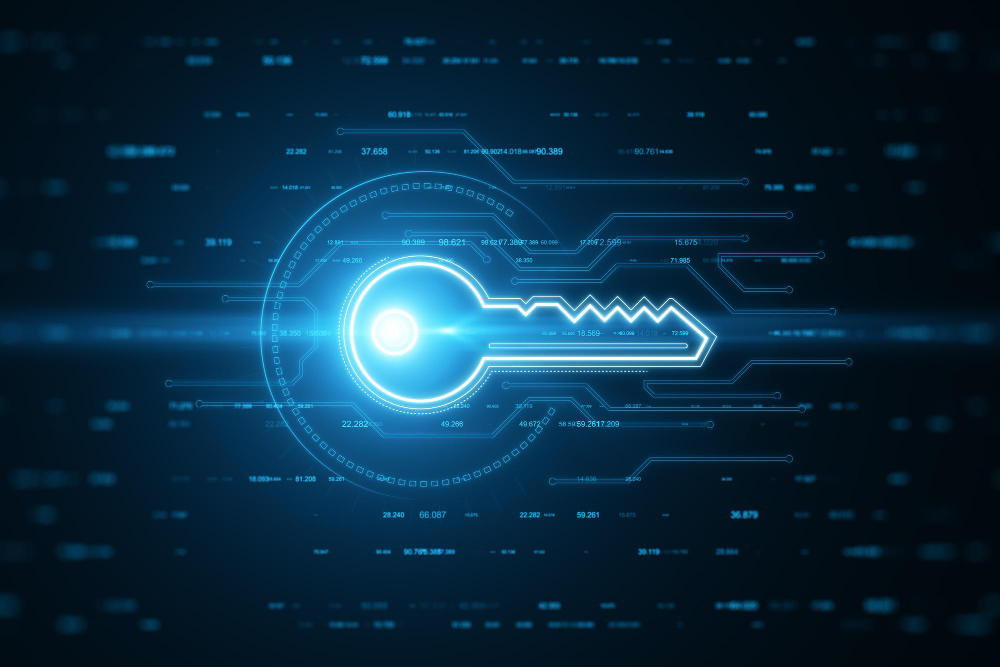Symmetric encryption is a trusted method for protecting data, using one encryption key to encrypt and decrypt information. The strength of this method lies in the encryption key and its key length, whose role is important in data confidentiality.
What makes this encryption so effective, and how does it compare to other key-based methods, such as those involving a public key?
Learn more about the power of symmetric encryption by reading our full article below!
What is Symmetric Encryption?

Symmetric encryption is an encryption type that uses one key to encrypt and decrypt data. This method applies a specific algorithm to secure information and ensure confidentiality.
In contrast to asymmetric encryption, which involves two keys, symmetric encryption depends on the secret key’s or session key’s strength.
What is Symmetric Encryption Used for?

Symmetric encryption is primarily used to secure data quickly and efficiently. It’s favored in scenarios where fast encryption and decryption are essential when handling large amounts of sensitive data.
Some real-life uses of this encryption are:
- Banking transactions
- Wi-Fi protection (WPA2)
- Disk encryption (BitLocker)
- Messaging apps (Signal, WhatsApp)
- VPNs (Virtual Private Networks)
Thanks to encryption algorithms like AES and DES, the process is reliable and quick. However, secure key exchange is crucial to maintaining its effectiveness.
How Does Symmetric Encryption Work?

Here’s a breakdown of the encryption process:
- Key generation: A secret symmetric key is generated and shared between the sender and receiver.
- Encryption: The data is converted into ciphertext using a symmetric encryption algorithm.
- Transmission: The encrypted data, now unreadable, is sent securely to the recipient.
- Decryption: The recipient uses the same key to decrypt the data and convert it to its original form.
The encryption algorithms come in two primary forms:
- Block ciphers: These encrypt data in fixed blocks, commonly with a block size of 128 bits, using a symmetric key. Popular examples include AES and DES.
- Stream ciphers: These encrypt data one bit or byte at a time, offering faster performance for real-time encryption. Stream ciphers are typically used in protocols like Transport Layer Security (TLS) to secure data in transit.
What are the Benefits of Symmetric Encryption?

The benefits of symmetric key encryption are numerous and critical for data security:
- Speed: Symmetric encryption algorithms are faster than asymmetric encryption, making them ideal for encrypting large amounts of data quickly and efficiently.
- Simplicity: Symmetric encryption uses one key (a secret key) for encryption and decryption, simplifying the process of securing data.
- Efficiency: This encryption method is highly efficient and consumes fewer resources because it uses a single symmetric key, which is beneficial for tasks like disk encryption and database encryption.
- Stronger with shorter keys: A shorter key length in symmetric encryption can still provide a high level of security.
These advantages make symmetric key encryption often used for real-time applications and large-scale data encryption tasks.
What are the Different Types of Symmetric Encryption?

Advanced Encryption Standard (AES)
AES encryption is a widely used symmetric encryption algorithm designed to secure sensitive data. It operates on fixed block sizes of 128 bits and supports key lengths of 128 bits, 192 bits, and 256 bits.
AES is known for its efficiency and high level of security, making it a popular choice for applications such as disk encryption and secure communications.
Data Encryption Standard (DES)
DES is an older block cipher that uses a 56-bit encryption key to secure data. It was once a dominant encryption method but is now considered less secure due to advances in computing power, making it vulnerable to attacks.
Blowfish and Twofish
These are symmetric encryption algorithms designed for fast and secure data encryption. Blowfish uses a variable key length ranging from 32 to 448 bits, making it highly adaptable. Twofish, its successor, is more secure and supports keys up to 256-bit key, which is ideal for protection against quantum computers and brute force attacks.
Both algorithms are known for their efficiency and are often used in applications that require bulk encryption, such as file encryption software and network security tools.
Triple DES (3DES)
Triple DES (3DES) is an enhancement of the original DES algorithm, which applies the DES encryption process three times with three different keys, providing stronger security. This symmetric encryption method extends the life of DES by increasing the key size to 168 bits, making it more secure than the original DES.
3DES is often used in legacy systems and whole disk encryption, although it is being phased out in favor of more advanced algorithms like AES.
What are the Differences between Symmetric Encryption and Asymmetric Encryption?

The differences between symmetric and asymmetric encryption include:
- Number of keys used
- Speed
- Key management
- Security level
- Common uses
Symmetric encryption uses one secret key for encryption and decryption, is faster and ideal for securing large amounts of data, requires a secure secret key exchange, and is typically used for disk encryption.
Meanwhile, the asymmetric one utilizes a private key for decryption and a public key for encryption, slower due to its more complex process, allows for easy public key sharing, and secures emails, digital signatures, and certificates.
Key Management for Symmetric Encryption

The key management of this encryption needs to be noted down, as you will see that it comes with many drawbacks. Here is what you need to know:
Attribution Data
In symmetric encryption, managing attribution data can be challenging because the same secret key is used for encryption and decryption. This makes it difficult to trace who performed the encryption or decryption, a potential security issue involving multiple users.
Key Exhaustion
Key exhaustion happens when a symmetric key is used too often, weakening its security over time. Frequent use increases the chances of the key being compromised, so it’s important to rotate and refresh the encryption key regularly to avoid exposing sensitive data to potential attacks.
Key Management at Large Scale
Handling key management at a large scale is a significant challenge in this encryption. As the number of users or devices grows, securely distributing and managing multiple keys becomes more difficult.
Without proper management protocols, there’s a higher risk of losing control over the keys, which can lead to data breaches.
Frequently Asked Questions
Do we still use symmetric encryption?
Yes, symmetric encryption is still widely used today due to its speed and efficiency in securing large amounts of data.
What are the pros and cons of symmetric encryption?
The pros of this encryption are that it is fast and efficient for large data encryption. Meanwhile, the cons involve requiring secure key exchange, and one secret key must be shared by both parties, which can pose security risks.
What is the main vulnerability of symmetric key encryption?
The main vulnerability is the need for secure key exchange since both parties must use the same secret key.
Conclusion
In summary, symmetric encryption continues to be a reliable and efficient method for securing large data sets. Its speed and straightforward approach make it widely used, though managing key exchange remains a critical challenge.
So, was the overview above easy to follow? If your business is seeking stronger digital security measures, contact Fluxgate.
We provide expert advice and solutions to help protect your company’s sensitive data with the most effective encryption strategies.
